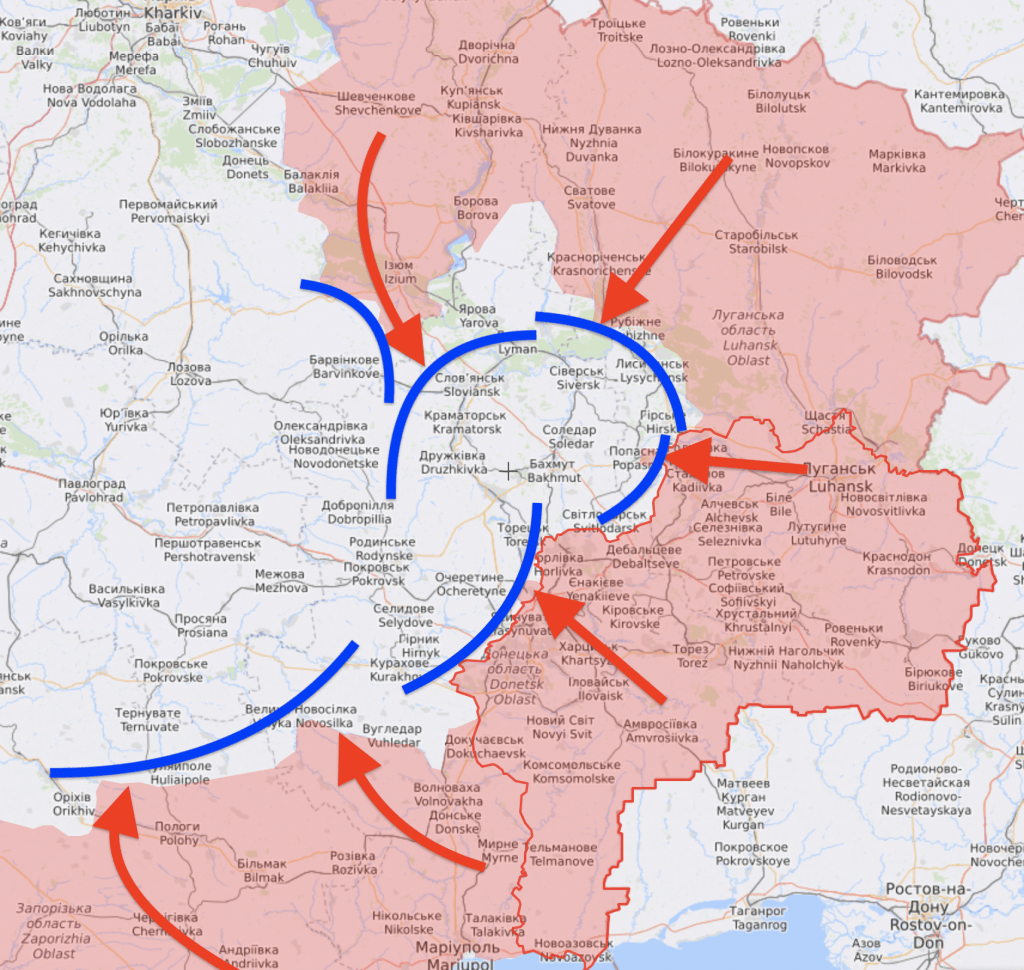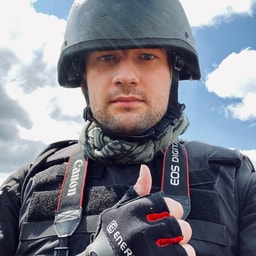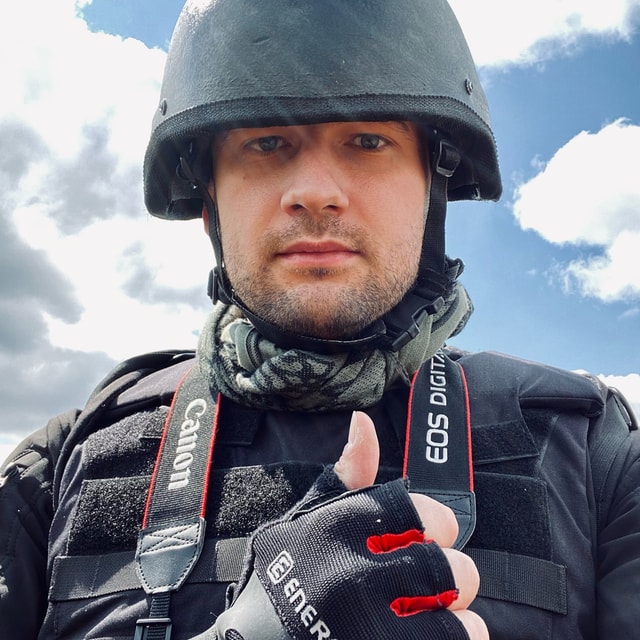
Ukraine and the world have spent weeks in anticipation of the Battle of Donbas, “the second phase” of Russia’s all-out war on Ukraine.
Now, it seems, the wait is over.
With the drastic intensification of hostilities in Donbas and neighboring areas, President Volodymyr Zelensky on April 18 finally confirmed the beginning of Russia’s large-scale offensive in Ukraine’s eastern Donetsk and Luhansk oblasts.
Ukraine and Russia are now engaged in what is likely the biggest battle in Europe since World War II.
It is likely to define the outcome of Russia’s entire campaign.
Russian preparations and the offensive have been carried out almost exactly as expected by the Ukrainian military and the expert community.
So what is Russia’s plan and why is the new offensive operation so important?
Why did Russia decide to switch to Ukraine’s east?
In late March, the Russian defeat in the Battle of Kyiv spelled the end to the Kremlin’s plan of a quick victory over Ukraine.
Contrary to expectations, the shock and awe assault on Ukraine’s capital city failed almost instantly.
Russian advancements east and west of Kyiv stalled amid logistics and supply troubles and extremely costly gains.
A series of Ukrainian counter-attacks near Kyiv, Chernihiv, and Sumy rendered the Russian positions even weaker. By the end of March, the Russian military had made the decision to withdraw from Kyiv, facing a potential disaster or, at least, no positive prospects in the area.
Along with Kyiv, the war’s initial main goal, Russia also gave up on Chernihiv and Sumy oblasts, operations against which had also proved fruitless.
Read also: New phase in war opens up as Ukraine defeats Russia in battle of Kyiv
Russia greatly underestimated Ukraine’s military power and its willingness to fight, sending Russia’s blitzkrieg over the edge. It cost Russia nearly a third out of its 120-125 battalion tactical groups (BTGs) that it had available for invasion, rendered ineffective or destroyed in action.
Notably, many of those battered combat formations were part of the well-known 2nd Guards Motor Rifle Division (“The Taman Division”) and 4th Guards Tank Division (“The Kantemir Division”), two of Russia’s most elite and combat-capable formations.
By early April, Russia had retreated from nearly 40% of the Ukrainian territories it had taken control of since Feb. 24.
In other key axes, particularly Mykolaiv and Kryvyi Rih, Russian offensives also stalled with no hope of any progress, derailing any potential strikes on Odesa and central Ukraine.

Russia managed to seize southern areas between Kherson and Mariupol, as well as gain a foothold near Kharkiv, while falling short of seizing the city.
Facing a total lack of manpower and resources, the Kremlin switched to a goal less monstrously ambitious — seizing the whole of Ukraine’s Donbas.
In just a snap, Russian state propaganda forgot about the “demilitarization” and “denazification” of the whole of Ukraine and instead began insisting on “the liberation of Donbas” as the Russian war’s ultimate goal.
What will this offensive look like?
After withdrawing from Ukraine’s north, Russia has spent the past three weeks redeploying these forces and moving up fresh reserves.
Much of the manpower has been sent to Russia’s Belgorod Oblast bordering Ukraine as well as to the vicinity of the key city of Izium in Ukraine’s Kharkiv Oblast.
The Izium axis is expected to try and advance farther southeast towards the city of Slovyansk. At the same time, another major axis coming from the south in Zaporizhia and parts of Donetsk oblasts are to meet up at the Slovyansk-Kramatorsk area in central Donbas.
Apart from the main strikes in the south and Izium, Russia is also carrying out a number of secondary strikes against the Sievierodonetsk-Lysychansk area in Luhansk Oblast and against Avdiivka in Donetsk Oblast, where it has had little to no progress for weeks.

In many ways, the plan bears a resemblance to the 1943 Battle of Kursk of World War II. During the battle’s initial phase, the Wehrmacht’s Operation Zitadel envisaged pinching off a 170-kilometer-wide Soviet pocket around the city of Kursk.
Two German strikes from the north and the south were supposed to meet up in the middle, trapping scores of Soviet troops in a giant pocket around Kursk.
But both German axes were exhausted in fierce and protracted fighting against deep defensive belts and then destroyed, which was one of the WWII key turning points.
Now in 2022, at a smaller scale in terms of the manpower involved on both sides, Russia is trying to generally follow the old German plan.
If Russia succeeds, the largest military group of Ukraine’s most combat-capable formations, the Joint Forces, could get trapped in a big pocket in Donbas, cut off from the rest of the country, exhausted, destroyed, or forced to surrender.
Such an outcome would be catastrophic to Ukraine’s position in talks with Russia, let alone the nation’s morale.
It could also leave the door open to Russia’s further advancement inside Ukraine towards Zaporizhia and Dnipro, with Ukraine’s military power seriously diminished.
How strong are the combating parties?
On April 18, Ukraine’s General Staff said Russia had concentrated 87 battalion tactical groups (up to 70,000 troops) all across Ukraine, including in the occupied south.
On the same day, the Pentagon said Russia, as part of its redeployment to Ukraine’s east, had added 11 BTGs, bringing their number to a total of 76 (nearly 60,000 troops).
More 22 BTGs were positioned north of Ukraine, likely to be replenished and refitted, according to the Pentagon.
At the same time, Zelensky said on April 14 that Russia would be trying to surround a Ukrainian group of nearly 44,000 troops in Donbas.
This number is likely to have increased, since, according to the Kyiv Independent sources in various formations of the Ukrainian military, scores of Ukrainian combat formations that had been victorious in the north had been redeployed to the east to reinforce the Donbas group in the wake of Russia’s offensive.

What are Ukraine’s chances of winning?
The Battle of Donbas of 2022 is unfolding in an area that is as wide as the famous Kursk salient of 1943.
This undoubtedly indicates a large offensive operation the modern Russian military has never had, and to which it never prepared, according to analysts studying the Russian military.
According to the basics of the science of war, an offending party should enjoy a threefold superiority over enemy manpower to reasonably expect success.
Based on the known data about how much of the military power Russia made available for the invasion of Ukraine, the Russian military and collaborationist militant forces in Donbas do not have this advantage, although they would probably be able to gain the upper hand at key points.
Moreover, the ongoing fierce Ukrainian defense of Mariupol, which has gone on for more than 50 days, has also prevented nearly 10,000 Russian troops (nearly a dozen BTGs) from being deployed to Donbas.
Russia, in its turn, will have to deal with heavily fortified Ukrainian defenses and cities that were prepared for a long and exhausting war.
The key metropolitan areas of the Ukrainian-controlled part of Donbas, such as Slovyansk-Kramatorsk, Sievierodonetsk-Lysychansk, Avdiivka, or Kurakhove, have been turned into strong fortresses that will be hard to get at.
Due to the extensive Ukrainian usage of Western-provided anti-aircraft and anti-tank weaponry, as well as the region’s dense urban areas, Russia’s supremacy in the air and on the ground will face serious challenges.
Moreover, as Western monitors indicate, Russia continues to face logistical issues and engage low-quality reserves.
Since the defeat in the Battle of Kyiv, embattled Russian forces have not been given enough time to rest and regroup.
“The Russians have not fully set conditions for a large-scale offensive operation,” the Washington-based Institute for the Study of War (ISW) said on April 19.
“The Russians have not had enough time to reconstitute forces withdrawn from the Battle of Kyiv and ready them properly for a new offensive in the east. The Russians appear to be still building logistics and command-and-control capabilities even as they start the next round of major fighting.”
Multiple indications suggest Russia had to hastily form new combat formations from the shatters of forces still combat-capable after the battles in northern Ukraine.
Many experts say such an unreasonable hurry could be precipitated by Russian dictator Vladimir Putin’s utter desire to reach his own political goals by winning the Battle of Donbas by May 9, the day when Russia celebrates WWII Victory Day.

It was likely because of this that General Alexandr Dvornikov, the South Military District commander having experience in leading very disparate formations in Syria, was appointed to lead the offensive operation.
According to reports on the ground, Russians have learned some lessons and are applying savvier and more reasonable tactics of probing Ukrainian defenses and avoiding direct combat contacts and reckless frontal attacks in favor of artillery duels and airstrikes.
What lies ahead, according to various assessments, is a hard and exhausting battle in which both sides are likely to sustain severe casualties.
But, as the ISW said on April 18, “the Russian offensive in the east is unlikely to be dramatically more successful than previous Russian offensives.”
“Russian forces may be able to wear down Ukrainian defenders or achieve limited gains… Russian forces may certainly be able to wear down Ukrainian positions in eastern Ukraine through the heavy concentration of firepower and sheer weight of numbers, but likely at a high cost.
"A sudden and dramatic Russian offensive success remains highly unlikely, however, and Ukrainian tactical losses would not spell the end of the campaign in eastern Ukraine, much less the war as a whole.”










